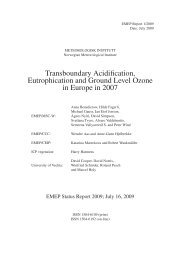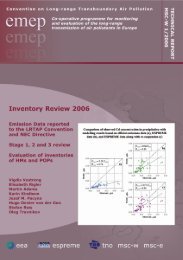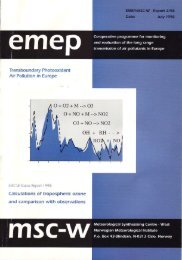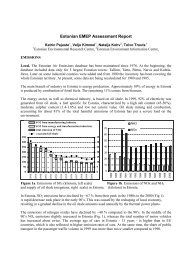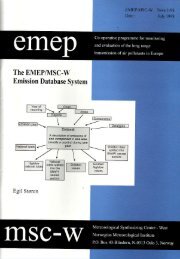ccc & msc-w - EMEP
ccc & msc-w - EMEP
ccc & msc-w - EMEP
You also want an ePaper? Increase the reach of your titles
YUMPU automatically turns print PDFs into web optimized ePapers that Google loves.
3. <strong>EMEP</strong> monitoring network for acidification and eutrophication<br />
This chapter presents the 1997 status of the <strong>EMEP</strong> monitoring network for acidification and<br />
eutrophication. The present status of <strong>EMEP</strong> monitoring network is discussed in relation to its<br />
envisaged goals and purposes, providing suggestions for the future development of the<br />
programme.<br />
Particular attention is given to clarify the present requirements of the <strong>EMEP</strong> network for<br />
acidification and eutrophication. General specifications in this chapter are complemented with<br />
the detailed evaluation of air and precipitation data for each country reported in the Appendix.<br />
This evaluation of country contributions to the <strong>EMEP</strong> network is intended to stimulate the<br />
communication between the countries and the <strong>EMEP</strong> centres. Reactions and comments are both<br />
welcome and encouraged.<br />
The following review shows that the present status of the <strong>EMEP</strong> network is satisfactory for<br />
precipitation data but not for the air data programme, where all required nitrogen components<br />
were not measured in 1997 at 60% of the stations. Recommendations for the future indicate the<br />
desirability of extending the <strong>EMEP</strong> networks to make them operational for control and<br />
surveillance purposes.<br />
3.1 Main objectives<br />
The main objective of <strong>EMEP</strong> is to provide an overview of the European situation with respect<br />
to pollution transport across national boundaries. <strong>EMEP</strong> should provide scientific support for<br />
the analysis of the relationships between emissions, atmospheric processes, air concentrations<br />
and deposition in a multi-disciplinary programme involving measurements, meteorological<br />
modelling and evaluation of effects.<br />
The main goals for the acidification and eutrophication programme are:<br />
• Determination of deposition fluxes for assessment of effects.<br />
• Quantification of transboundary fluxes and source allocation of estimated<br />
or measured deposition fluxes.<br />
• Surveillance of the progress towards the reduction of deposition fluxes, in<br />
particular as they concern exceedances of critical loads.<br />
• Verification of the reductions of sulphur and nitrogen emissions as<br />
prescribed by the Protocols to the CLRTAP.<br />
41



